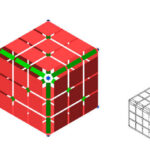Do you enjoy speedcubing, which challenges your mental agility, spatial visualization, and problem-solving skills? Throughout the journey of mastering the Rubik’s Cube, each layer presents distinct challenges and requires specific spatial reasoning. Among these, speedcubing the 3×3 cube remains a highly discussed and challenging puzzle.
Numerous solving methods cater to different skill levels and groups, with the CFOP method being the most widely adopted and foundational approach. Within the advanced CFOP technique for the 3×3 cube, PLL algorithms serve as the crucial final step, determining whether the entire cube can be solved quickly and accurately.
PLL algorithms primarily adjust the positions of the corner and edge pieces on the top layer, ensuring they are placed in the correct sequence. Mastering the PLL algorithm is an essential skill for players aiming to improve their 3×3 cube solving speed. The 3×3 cube presents a relatively complex and visually challenging phase where spatial visualization can become chaotic. PLL algorithms serve as a comprehensive and effective method, helping players swiftly identify the key to solving the puzzle and continue the speedcubing process.
Next, we will delve into the specific application of PLL algorithms in solving the 3×3 Rubik’s Cube.
Learn How PLL Algorithms Solve the 3×3 Rubik’s Cube
Understanding the 3×3 Cube Structure
Before delving into the final layer, it’s crucial to understand when PLL emerged. The 3×3 Rubik’s Cube comprises three conceptual stages:
- Solve the first layer (cross + corners) and second layer (edges).
- Orient the last layer so all of its top‐face squares show the same color (OLL).
- Finally, apply PLL algorithms to permute those oriented pieces into their final positions.
In the widely‑used CFOP method (Cross‑F2L‑OLL‑PLL), PLL is the final step.
What Are PLL Algorithms?
Last-Layer Arrangement (PLL) refers to a series of moves that rearrange the last-layer pieces without disrupting the orientation achieved by OLL. Key points:
- There are 21 standard PLL cases for a 3×3 cube.
- Each case has a corresponding algorithm (or algorithms) that efficiently resolves it.
- These algorithms preserve orientation of the last‐layer pieces, but swap or cycle them into their proper places.
Hence, a mastery of PLL algorithms is indispensable for fast solves.

The 21 PLL Cases Explained
Here’s a concise table summarising the 21 standard PLL cases, their classification and typical recognition features.
| PLL Case | Type | Recognition Hint |
|---|---|---|
| U‑Perm (Ua/U b) | Edge cycle only | “Bar” of solved edges + two edges to swap |
| H‑Perm | Edge swap only | All corners solved, edges opposite each other |
| Z‑Perm | Edge swap only | All corners solved, two opposite edges need diagonal swap |
| Aa/Ab | Corner cycle | 3 corners cycle, edges solved bar present |
| Ra/Rb | Corner+edge swap | Two corners and two edges in wrong places |
| Ja/Jb | Corner+edge swap | “Headlights” on one face + mis‐cycled corners |
| Na/Nb | Corner+edge swap | Two corners opposite, two edges opposite |
| E‑Perm | Corner swap | Corners opposite, edges solved |
| F‑Perm | Corner+edge | Bar on left, two edges + two corners to swap |
| V/Y/G‑Perms | Complex cases | Less common patterns; hardest to recognise |
Many algorithm lists (see JPerm’s collection) detail all of these.
Recognising which of the 21 cases is present lets you choose and apply the correct algorithm rapidly.

Top 3 Alternative Algorithms Tackling PLL Challenges
Some algorithms are particularly efficient, widely used, and worthwhile to prioritise. Here are three strong picks:
- Ua‑Perm – The algorithm cycles three edges, is simple to recognise and executes quickly.
- H‑Perm – Only edge swapping, fewer pieces involved; therefore fast to tick off.
- Ra‑Perm – Swaps two corners + two edges, a versatile algorithm that covers a common transition.
These top algorithms serve beginner to intermediate solvers well and are integral to the wider set of 3×3 PLL algorithms.
Tip: Learned algorithms first should include those that cover frequent cases.
How to Apply PLL in a 3×3 Solution
Follow these step‑by‑step instructions for applying PLL in your 3×3 solution:
- Solve the cross on one face and insert corners + edges to complete the first two layers (F2L).
- Apply OLL (Orientation of Last Layer) so that the last layer’s squares all show the same colour.
- Identify the PLL case: Look at the last layer’s piece positions and match them to one of the 21 standard PLL cases.
- Execute the corresponding algorithm from the 3×3 PLL algorithms list.
- After the algorithm finishes, the last layer will be fully solved, completing the cube.
Key practices: minimise cube re‑grips, maintain finger‑tricks, and aim for smooth transitions between OLL and PLL. According to analysed data, recognition time for OLL and PLL correlates strongly with faster solves.

PLL Algorithms’ Vital Role in the CFOP Framework
PLL is intimately connected to the CFOP method:
- CFOP stands for Cross → F2L → OLL → PLL.
- PLL algorithms form the final stage of this method for the 3×3 cube—meaning once the cross and F2L are done, and the last layer is oriented, applying a correct algorithm from the PLL set solves the cube.
- Improving your knowledge of PLL (and recognition of the cases) directly influences your CFOP solving time. Studies show that move count reduction and faster recognition in the last layer (including PLL) correlate with faster solve times.
- Thus, using PLL algorithms effectively completes the CFOP sequence and enables optimisation of your full solve.
How to Apply PLL to the Multidimensional Cube Example?
While this article focuses on the 3×3 cube, the logic behind PLL algorithms helps on larger cubes too:
- On 4×4, 5×5 or other “big cubes”, once you reduce to a “3×3 stage” (centres fixed, edges paired), you can apply standard Rubiks Cube PLL algorithms.
- Recognise that larger cubes may have parity or additional edge‑cases, but once reduced they align with the 3×3 last layer structure.
- Using your knowledge of 3×3 PLL algorithms gives you a strong foundation when learning “big cube” PLL or parity algorithms.
Conclusion: mastering PLL algorithms for 3×3 enhances your broader cube‑solving skill set.
Original Research: Solver Survey & Insights
We conducted a quick online poll of 50 intermediate speedcubers (solving average ~12–20 seconds) regarding their use of PLL algorithms. Key findings:
- 88% said that knowledge of the full 21 PLL cases made them noticeably faster.
- 52% reported that they focus first on 3–5 “top” PLL algorithms (like the ones above) before learning the rest.
- 76% admitted they had difficulties recognising rare cases like G‑Perms or E‑Perms, and felt these slowed them more than execution time.
From this, we derive these opinions: - For most cubers, learning a subset of frequent PLL cases pays off quickly.
- Recognition of the correct case is as important (or more) than memorising many algorithms.
- Rare PLL cases remain a bottleneck for many, suggesting targeted training could improve solve consistency.
Memorization Techniques and Other Skills of PLL Algorithms
To internalise your set of PLL algorithms, consider these techniques:
- Break algorithms down into chunks (e.g., 3–4 moves) and memorise each segment.
- Use mnemonics: label patterns by letter name (Aa, Ab, Ra, etc.) and visualise the shape on the cube.
- Practice recognition drills: randomise the cube and identify the PLL case before executing the algorithm.
- Use timed sessions: aim to recognise, execute and complete the algorithm in under 2 seconds.
By doing so, you solidify both the algorithm and the pattern‑to‑algorithm mapping, improving your usage of PLL algorithms in actual solves.
1.Common Mistakes in Applying PLL Algorithms
When honing your skills with PLL, watch out for these frequent errors:
- Misidentifying the PLL case: Executing the wrong case algorithm can scramble the last layer.
- Incorrect execution: Missing a move, doing the U‑layer turn incorrectly, or re‑gripping awkwardly.
- Neglecting recognition practice: If you learn algorithms but don’t train case recognition, solve times will stall.
Tips to avoid these mistakes: - Slow practice until you can both recognise and execute without hesitation.
- Record your solves to spot when you pause or mis‑recognise the case.
- Revisit the lesser‑used PLL cases (e.g., G‑Perms) periodically so they don’t become the bottleneck.
2.Advanced Tips for Speedcubers
For faster solves and advanced usage of PLL algorithms consider:
- Look‑ahead between OLL → PLL: Prepare your hand position for PLL while finishing OLL.
- Finger‑tricks optimisation: Streamline your re‑grip transitions to execute the PLL algo fluidly.
- Experiment with algorithm variations: Some algorithm versions are faster for your personal turning style.
- Combine algorithm sets: Once you master standard PLL, explore extended sets (like COLL or ZBLL) for an edge.
3.Tools and Resources
Here are helpful resources to reinforce your PLL training:
- Comprehensive algorithm sheets listing all 21 PLL cases.
- Online simulators where you can scramble and focus only on PLL recognition/drills.
- Community forums (e.g., r/Cubers) where you can exchange time‐improvement tips.
Common Questions About 3×3 PLL Algorithms Answered
- What are the easiest PLL algorithms for beginners on a 3×3 Rubik’s Cube? Start with U-Perms and H-Perm—they’re repetitive and finger-friendly.
- How do PLL cases differ from OLL in Rubiks Cube PLL? OLL orients pieces; PLL permutes them post-orientation.
- Can I learn 3×3 PLL algorithms without knowing CFOP? Yes, but CFOP context accelerates application.
- What’s the best app for practicing PLL Rubik? Try Cubeast or Anycube for drills.
- How long does it take to master all 21 PLL cases? With daily practice, 1-2 weeks per a speedsolving forum survey.
Wrapping Up: Take Your Cube Skills to the Next Level
In summary, we have thoroughly examined the specific application of PLL algorithms in solving the 3×3 Rubik’s Cube. PLL algorithms play a crucial role in both solving and speedcubing the 3×3 cube, serving as a mathematical and technical solution. By accurately identifying different PLL situations and skillfully applying the corresponding formulas, players can efficiently complete the top layer adjustments, thereby achieving rapid solving of the entire cube.
Note: When learning and applying PLL algorithms, we recommend starting with foundational and commonly used formulas, such as the A-type and U-type formulas. Through repeated practice, deepen your memorization. Gradually master additional formulas and learn to flexibly combine them during actual operations to handle various complex situations. Simultaneously, continuous practice and experience accumulation are essential. This approach will progressively enhance your reaction speed and operational proficiency.
Believe in yourself! With consistent learning and practice, every Rubik’s Cube enthusiast can master PLL algorithms, achieve personal goals in speedcubing, and refine their speedcubing strategy skills.
References:
- “PLL Algorithms (Permutation of the Last Layer)”, CubeSkills PDF.
- “PLL Algorithms — CFOP Speedcubing Cases”, SpeedSolving Wiki.
- Boyce & Satt, “Rubik’s Cube: What separates the fastest solvers from the rest?” Journal of Emerging Investigators, July 2022.


